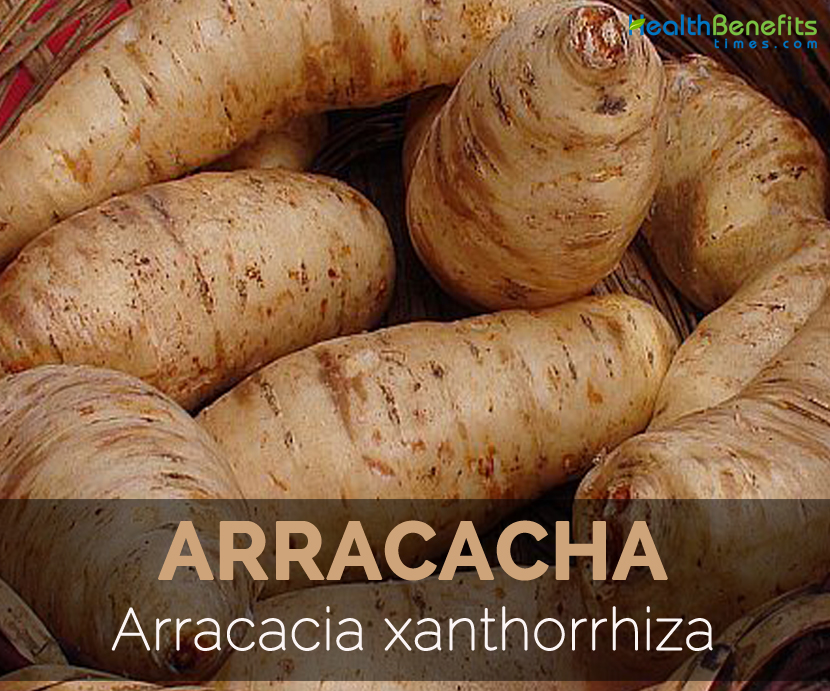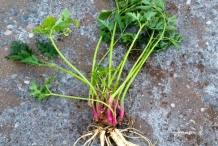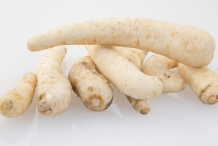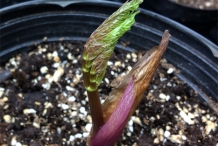| Arracacha Quick Facts |
| Name: |
Arracacha |
| Scientific Name: |
Arracacia xanthorrhiza |
| Origin |
Originally from Andes. It is also available in various Central and South American countries such as Brazil, Peru, Venezuela, Dominican Republic, Ecuador and Puerto Rico. |
| Colors |
White (Root) |
| Shapes |
Long, thin, spindle; Length: 2 and 10 inches (5-25 cm); Diameter: 1-2 inches (2-6 cm) (Root) |
| Flesh colors |
White, yellow or purple |
| Calories |
104 Kcal./cup |
| Major nutrients |
Iron (112.50%)
Vitamin B3 (26.88%)
Vitamin C (25.56%)
Carbohydrate (20.54%)
Magnesium (15.01%)
|
| Health benefits |
Chronic ailments, Pregnancy, Cardiovascular ailments, Pellagra, Treats gout |
| More facts about Arracacha |
Arracacia xanthorrhiza (commonly called Peruvian Parsnip, Peruvian Carrot and White Carrot) is a caulescent and herbaceous plant native to Andes of the Apiaceae /Umbelliferae family. It is cultivated as a perennial plant. It is sweet and nutty tasting root vegetable with smooth white skin. The young leaves and stems are sometimes consumed as greens or added to salads. This plant performs great in well-drained soils.
The plant is a stout, caulescent and herbaceous herb, bearing ovate, dark green to purple, tripinnate leaves each measuring 1-3 cm long and broad. It bears oval shaped purplish to maroon flowers. The edible tuberous root is 2 and 10 inches (5-25 cm) long and 1-2 inches (2-6 cm) in diameter. Its flesh ranges from white, yellow and purple. The stems are green, cylindrical and smooth. Fruits are one seeded, oblong measuring up to 10 mm long and 2-3 mm across.
History
Arracacha is originally from Andes. It is also available in various Central and South American countries such as Brazil, Peru, Venezuela, Dominican Republic, Ecuador and Puerto Rico. This plant is also cultivated in Japan, North America and Europe. Recently it got introduced in the some parts of Australia. Arracacha was grown since at least 1903 in Puerto Rico. In the late 1800s, Arracacha was introduced to Brazil. Arracacha was introduced in 1910 to Puerto Rico.
Nutritional Value
100 grams of Arracacha provides 0.505 grams of protein, 0.28 grams of total fat, 1.3 grams of ash, 26.7 grams of carbohydrate and 0.85 grams of dietary fiber. It grants 9 mg of Iron, 4.3 mg of Vitamin B3, 23 mg of Vitamin C, 63.05 mg of Magnesium, 0.1 mg of Thiamin and 50 mg of Phosphorus.
Health Benefits of Arracacha
Arracacha is acknowledged as one of the nutritious root vegetables found in the world. It is rich in carbohydrate, mineral and vitamin contents which is essential to maintain human health. The starch found in this vegetable is beneficial to the old people and small children. It has low amount of calories. The studies show that it helps to reduce the chances of cancers such as breast cancer, lung cancer and colon cancer.
- Chronic ailments
Iron helps to treat the chronic ailments such as chronic diseases of excretory and intestinal system and renal failure anemia. Iron is essential for the functioning of various processes in the body’s system such as circulatory system. (1)
- Pregnancy
During pregnancy, the lack of iron increases the chances of premature birth or underweight newborn. The babies who are prematurely born experience various health problems in cognitive development and delayed growth. The study shows that the intake of iron supplements reduces the chances of underweight new born by 8.4 percent. (2)
- Cardiovascular ailments
Vitamin B3 maintains the balance between triglycerides and cholesterol levels which has positive effect on the heart health. It is also able to lower atherosclerosis which is the harmful arteries hardening that leads to the heart diseases.
It also reduces the histamine production and inflammation with the improvement of circulation. Vitamin B3 reduces the chances of reoccurrence of heart attack or cardiac arrest in those who had already experienced. (3)
- Pellagra
The deficiency of Vitamin B3 experiences the health ailments such as digestive problems, weak muscles, pellagra or skin irritation. The people with these problems should increase the intake of Vitamin B3 in their diet. (4)
- Treats gout
Vitamin C helps to reduce the chances of gout which is the condition where big toe is afflicted. The big toe becomes painful, inflamed and stiff due to the formation excess uric acid to crystals in the joints. The study shows that the intake of Vitamin C in 1000-1499 mg regularly reduces the chances of gout by 31%. (5)
- Treats cancer
The high intake of fruits and vegetables minimizes the chances of cancer of various types. The study shows that the high intake of vitamin C reduces the chances of mouth, lung, vocal chords, rectum, throat, colon, stomach and esophagus cancers. (6)
- Assist cardiac function
Vitamin B1 assists in neurotransmitter acetylcholine production which transfers the messages between the muscles and nerves. It enhances the cardiac functions. The deficiency of Vitamin B1 can interrupt in the cardiac functions. The people with congestive heart failure should be provided Vitamin B1 daily for a week so that it shows some improvement in their conditions. Vitamin B1 helps to prevent heart disease. (7)
- Enhance mood
Vitamin B1 enhances the body’s ability and acts as the anti-stress vitamins. Lack of energy contributes to the poor motivation and mood. Vitamin B1 enhances the mood and defends the body against anxiety and depression. It has positive effect on the brain. It eliminates the inflammation and maintains the brain functions. It also maintains the healthy nerves function which is responsible to control anxiety, stress and enhancing mood. (8)
- Assist digestion
Arracacha is well known for the supplements of baby food. In South America, the herbal puree is regarded as an excellent baby food. The herbal puree cooked with the use of Arracacha is provided to the babies as it is digestible due to the presence of small starch grains. For the older people, it could be sweetened or made savory. It is an excellent source of calcium, starch, Vitamin A and iron.
- Lose weight
The study shows that it is found in the weight loss regime. Arracacha possess complex carbohydrates like potatoes. The foods rich in calories keep the stomach full for a long time which helps to avoid binge eating and hunger pangs.
References:
http://www.vitaminsestore.com/arracacha-benefits-reviews-side-effects-and-dosage/
http://www.cabi.org/isc/datasheet/6973
http://ecocrop.fao.org/ecocrop/srv/en/cropView?id=3386
https://www.cultivariable.com/instructions/how-to-grow-arracacha/
http://www.wisegeek.com/what-is-arracacha.htm
http://www.onlyfoods.net/arracacha.html
https://sites.google.com/site/knowyourvegetables/know-your-arracacha
Comments
comments





